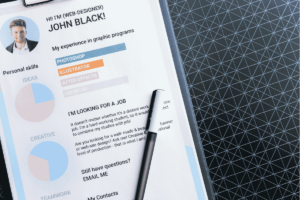Upgrade Your Career and Earn More Money in 2025!
In short:
This guide breaks down the essential steps to get hired and boost your income in 2025.
🧑💻Learn how to craft a resume that stands out
🥇 Make a great impression in interviews &
🏆 Confidently negotiate your salary and benefits to ensure you’re paid what you’re worth.
Watch the video or read the full breakdown below.
Get Hired and Grow Your Salary
As the end of the financial year approaches, it’s a natural time to reflect on your financial position – and that absolutely should include your income.
In today’s economic climate, with the cost of living continuing to rise, there’s a critical truth we need to face: if your salary hasn’t grown at least in line with inflation, you’ve effectively gone backwards. You’re earning the same (or close to it), but your money simply doesn’t stretch as far as it used to.
Closing this gap in your income is vital for building financial security and achieving your goals. So, what are your options?
You could aim for a raise in your current role, explore ways to boost your income through a side hustle, or find a new position that offers a higher salary.
If you’re considering that third option – landing a new role that pays more – then this blog post is for you.
To help you put your best foot forward in navigating the competitive job market and securing a higher income, Fox and Hare’s Head of Advice, Courtenay Walker sat down with HR queen, SEEK’s 2021 recruitment leader of the year and founder of Lotus People, Australia’s top recruitment agency for candidate experience five years in a row, Sinead Connolly.
With her extensive experience seeing thousands of resumes every week and guiding countless individuals through the hiring process, Sinead offers invaluable insights to share on how to get hired!
And we’ve distilled the key takeaways from their conversation into this guide, covering the three crucial stages of your job search:
- Crafting a standout resume that makes a powerful first impression,
- Making a great and lasting impression in interviews to showcase your value, and
- Confidently negotiating your salary and other benefits to ensure you’re fairly compensated.

Is your salary keeping pace? “If your salary hasn’t grown at least in line with inflation, you’ve effectively gone backwards.” Says Fox & Hare’s Head of Advice, Courtenay Walker.
Crafting a Standout Resume
In a competitive job market, your resume is your initial handshake with a potential employer.
With hiring managers and recruiters sifting through potentially hundreds of applications for a single role, getting yours to stand out from the digital pile is essential.
This section will equip you with the knowledge to create a resume that not only gets read but makes a memorable, positive impression, addressing the common frustration of applications disappearing into a black hole.
Sinead, who sees thousands of resumes weekly, shared her top tips for creating a document that catches a hiring manager’s eye.
Key Principles for a Resume That Gets Noticed:
- Keep it Simple and Readable:
Forget overly complicated designs and graphics. Recruiters are often sifting through hundreds of applications, and a clean, simple format is easiest to scan. Stick to standard, professional fonts like Calibri 11. Courtenay noted, while creative resumes might look lovely in isolation, simplicity is key when reviewing in volume. - Provide Detail in Your Bullet Points:
Don’t just list duties. Use bullet points to describe your responsibilities and achievements in enough detail to paint a clear picture of your experience and impact. Short, brief points aren’t enough to convey a lot. - Use Strong Action Verbs:
Start your bullet points with action words that demonstrate your capabilities, such as “led,” “managed,” “developed,” or “responsible for”. - Tailor Your Resume for Each Role:
Customise your resume to highlight the skills and experiences most relevant to the specific job description. This shows you’ve taken the time to understand what they’re looking for and makes it easy for the hiring manager to see your relevance.

Tailoring your resume for each job description is crucial for relevance and getting noticed by AI and recruiters.
Navigating Technology and AI in the Application Process:
It’s no secret that technology plays a significant role in recruitment today, with many organisations using AI to vet applications.
- Understand AI Screening:
AI tools often scan for keywords and achievements mentioned in the job description. Ensure your resume includes relevant terms and clearly highlights your accomplishments to avoid getting lost in the system. - Leverage AI Tools Smartly:
Tools like ChatGPT can be incredibly helpful for refining your bullet points, tailoring your resume content to specific roles, or drafting cover letters. As Sinead shared from helping her cousin, you can use it in chunks to maintain your style or ask it to pull out key experience related to a job description. However, Sinead emphasizes that it’s crucial to add your personal touch and ensure the language sounds like you. Don’t just copy and paste – make it your own!
Common Resume Mistakes to Avoid:
Sinead shared some common errors that can hinder your application:
- Including Information Prone to Bias:
Avoid including personal information like your date of birth or including a photo on your resume. This can unintentionally introduce bias into the selection process, and you don’t know who will be reading it. - Unprofessional Email Addresses:
Make sure the email address you use is professional. As Courtenay lightheartedly put it, avoid anything like [email protected] – it happens more often than you’d think! Create a new, professional Gmail account if needed. - Obsessing Over Length:
Don’t sacrifice readability and detail just to fit everything onto one or two pages. Aim for around three to four pages, especially if you have a longer career history, to adequately include details and achievements. Avoid going much over four pages, but don’t condense so much that your experience isn’t clear. - Using Difficult-to-Parse Formats:
While creative resumes (like those made in Canva) are great for roles where design is relevant (e.g., marketing, graphic design), for most non-creative positions, a standard document format (like Word) is preferred as it’s more easily processed by recruitment software and applicant tracking systems. While not all systems exclude PDFs, a simple, easily accessible format is generally preferred for non-creative roles. - Submitting Generic Cover Letters:
Your cover letter is an opportunity to express genuine excitement for the specific role and clearly articulate why you are a strong fit. Avoid simply restating your resume content. While addressing key requirements from the job ad in your cover letter can be helpful, you don’t need to go into excessive detail on every single point – make it easy for the reader to see your relevance quickly. - Not Including LinkedIn (and keeping it updated):
Your LinkedIn profile is a valuable extension of your resume. Include a link to your profile and ensure it’s complete and professional. Hiring managers may look at your LinkedIn to get a broader sense of your professional presence, interests, and how you engage online. Being active and engaging on the platform can also be beneficial, particularly in fields where personal branding is valued.

Sinead advises against including a photo on your resume to avoid potential bias.
Making a Memorable Impression in Interviews
Congratulations, your standout resume worked, and you’ve landed an interview!
This is your chance to move beyond the written word and personally connect with the hiring team, showcasing your personality and fit for the role and company culture.
Many people find interviews daunting, but with the right preparation, you can walk in with confidence and leave a lasting positive impression.
This section will provide you with the tools and insights to feel prepared, communicate your value effectively, and navigate the interview process successfully.
Securing an interview means you’ve got your foot in the door – now it’s time to make a lasting impression. Sinead and Courtenay shared their advice on how to shine during this crucial stage.
Thorough Preparation is Your Best Friend:
Both experts emphasised that preparation is the most important factor in a successful interview.
- Research the Company Deeply:
Go beyond their website’s “About Us” page. Understand their values, culture, recent projects, and what seems to be important to them. Sinead suggests looking at their employer brand and how they present themselves.
- Understand the Role Inside and Out:
Be clear on the responsibilities and challenges of the position.
- Research Your Interviewer(s):
If you know who you’ll be meeting with, look them up on LinkedIn. Understanding their background and career trajectory can help you connect with them and tailor your responses. Don’t hesitate to ask the recruiter or HR contact for the names of the interviewers if you don’t have them – Courtenay advises, it’s fine to ask!
- Prepare Insightful Questions:
Asking thoughtful questions demonstrates your interest and engagement. Prepare questions that go beyond the basics, perhaps asking about the team culture, challenges in the role, or what success looks like in the first six months. Frame your questions around solving their problems.

Prepare thoughtful questions to ask – they show you’ve done your research and are genuinely interested.
During the Conversation:
- Show Genuine Eagerness:
Let your enthusiasm for the role and the company shine through. This is particularly impactful when interviewing with smaller businesses where passion for the company’s mission is highly valued.
- Be Responsive and Accessible:
Prompt communication before and after the interview process is key. Sinead notes that simply being accessible and responsive can make you stand out positively, as it’s surprisingly not always the norm. Avoid being late or difficult to reach – these can be considered “red flags”. Aim to accumulate “green flags” throughout the process by being responsive, easy to reach and pleasant to deal with.
- Weave in Your Achievements:
Be ready to share specific examples of your accomplishments and the impact you’ve made in previous roles. Sinead shared an example of a candidate who easily wove her wins into the conversation, which made a great impression. Reflect on your past experiences and achievements to have these examples ready. - Balance “I” and “We”:
When discussing your contributions, use a mix of “I” and “we” to show both your individual drive and your ability to work effectively in a team.
Always follow up
It’s a simple step but always follow up with your contact at the organisation! Send a thank-you note or email after the interview. This is a chance to reiterate your interest and briefly mention something specific you discussed, leaving a lasting positive impression.

Being responsive and accessible throughout the process is a simple yet effective way to make a positive impression.
Strategically Negotiating Your Salary and Benefits
You’ve aced the interview and received a job offer – congratulations!
This is a significant achievement, and now comes the part that many people find intimidating: negotiation. However, this is a critical step to ensure your compensation package reflects your skills, experience, and market value.
This section will empower you with strategies to confidently approach salary and benefit discussions, overcoming the fear of asking for what you’re worth and maximising your overall remuneration.
Preparation is Crucial for Negotiation:
- Research Your Market Value:
Before you even start applying, research the typical salary range for similar roles in your location and industry using resources like SEEK and LinkedIn. This understanding is fundamental to knowing your worth.
- Determine Your Desired Range:
Be clear on your salary expectations from the first conversation and communicate a range. Avoid significantly increasing your ask later in the process, which can waste time and seem less transparent.
- Be Confident in Your Worth:
Based on your research and experience, be prepared to confidently ask for a salary within or at the higher end of your desired range. Sinead noted that confidence plays a significant role, and research suggests men are more likely to ask for and receive higher salaries. Asking the question is the first step!
- Leverage Other Offers Strategically:
If you have other job offers that are higher, you can use this information as leverage in your negotiation for your preferred role. Clearly communicate that this is your preferred opportunity while mentioning other offers as a reason for seeking a higher salary.
- Understand Company Constraints:
Be aware that companies may have internal salary bands or budget limitations that could impact their ability to meet your initial salary request. It’s worth asking, but understand there might be restrictions.
- Propose Alternatives if Salary is Fixed:
If the company cannot meet your salary expectation right away, propose a salary review in six months tied to achieving specific performance goals. This shows your commitment and provides a path for future growth.
- Highlight Your Value:
Clearly articulate the value you will bring to the organisation and how your skills and experience justify your salary request.
- Changing Jobs as an Opportunity:
Sinead pointed out that moving to a new company is often the most opportune time to secure a significant increase in salary compared to waiting for internal reviews. - Companies Want to Hire You:
Remember that by the offer stage, the company has likely invested significant time and resources in the hiring process and would generally prefer to reach an agreement with their preferred candidate rather than starting over. This gives you leverage in the negotiation.

Research market rates on platforms like SEEK and LinkedIn to understand your worth before negotiating.
Negotiating Beyond Salary: Additional Benefits
Compensation isn’t just about the base salary. Many other benefits can significantly enhance your overall package and contribute to your work-life balance and personal growth.
- Identify Your Priorities:
Think about what non-salary benefits are most important to you and your lifestyle. This could include:
- Flexibility:
Remote work, hybrid work arrangements, or flexible hours to accommodate personal needs like school pickups.
- Professional Development:
Allocation for training courses, conferences, or a strong internal training program.
- Wellness:
Gym memberships, access to counselling or EAP programs.
- Other Allowances:
Don’t be afraid to think outside the box! Companies may be willing to tailor benefit packages if you communicate your needs. Courtenay shared a great real-life example of providing a “rice allowance” for employees in the Philippines who valued it highly.
By being prepared, confident, and clear on your priorities, you can effectively negotiate both your salary and other benefits to create a compensation package that truly works for you.
Ready to Take the Next Step in Your Career?
Navigating the job market in 2025 requires preparation, confidence, and a clear understanding of your value. By implementing the strategies discussed in this guide – from crafting a standout resume and acing your interviews to confidently negotiating your salary and benefits – you can increase your chances of landing your dream job.
You can find Sinead on LinkedIn and Lotus People through their website https://www.lotuspeople.com.au/. There you will find a whole host of resources from job vacancies to FAQs and trends in the job market.
If you’re interested in working with Fox & Hare specifically, your best bet is to connect with Courtenay directly via LinkedIn or email ([email protected]) and tell her why you’re a perfect fit.

Be confident in advocating for yourself and communicating your desired salary range early on. Don’t forget to negotiate beyond salary! Consider flexibility, professional development, wellness programs, and other benefits important to you.
About Fox & Hare:
Fox & Hare are the Millennial and Gen Z advisers, 100% focused on helping Australia’s 20-45 year olds buy property, get invested and achieve financial freedom.
When it comes to managing your money, it’s normal to feel uncertain or scared of making the wrong decision; it’s normal to feel so overwhelmed that, despite knowing you need to do something, the first step seems impossible; and it’s also incredibly normal to be earning great coin, but still feeling like you’re behind.
At Fox & Hare we create bespoke, long term financial plans that eliminate these uncertainties and put you in control of your financial future. No more option paralysis. No more fear of missing out. No more uncertainty about how to manage your money effectively.
If you:
- Want to achieve financial freedom.
- Want the flexibility to live your life on your terms, not tied to a job or working 24/7.
- Want your money to be working for you – not the other way around.
But the idea of learning how and where to start is more than a little daunting, let Fox & Hare do the legwork for you.
Read more insights from our experts
Get Paid What You’re Worth: Your Guide to Getting a Raise in 2025
Ask for a raise, get paid what you’re worth in 2025! In short: This webinar breaks down the essential steps to prepare your case,...
Your Super: What the New $3 Million Tax Changes Mean for You
Will Albo’s changes to super affect you? We’ve broken down the Government’s superannuation changes so you can understand what’s actually happening, what isn’t, and...
Zac set a goal to save 100k before graduation
Here’s why he’s happy that he ‘failed’. In short: Zac’s goal to save $100,000 before graduation led him to create a “bucket” system for...
“I’m a Foster Mother to 8 Children”
In a nutshell: Nanay (mother) Butch is one of twelve foster mothers at SOS Children’s Village, Cebu. Together they provide loving homes to 116...
🍖 BBQ Bites: Tariffs
Tariff. A beautiful word. We’re 37 days into the new American administration and it’s been a doozy. The headlines are flowing so thick and...